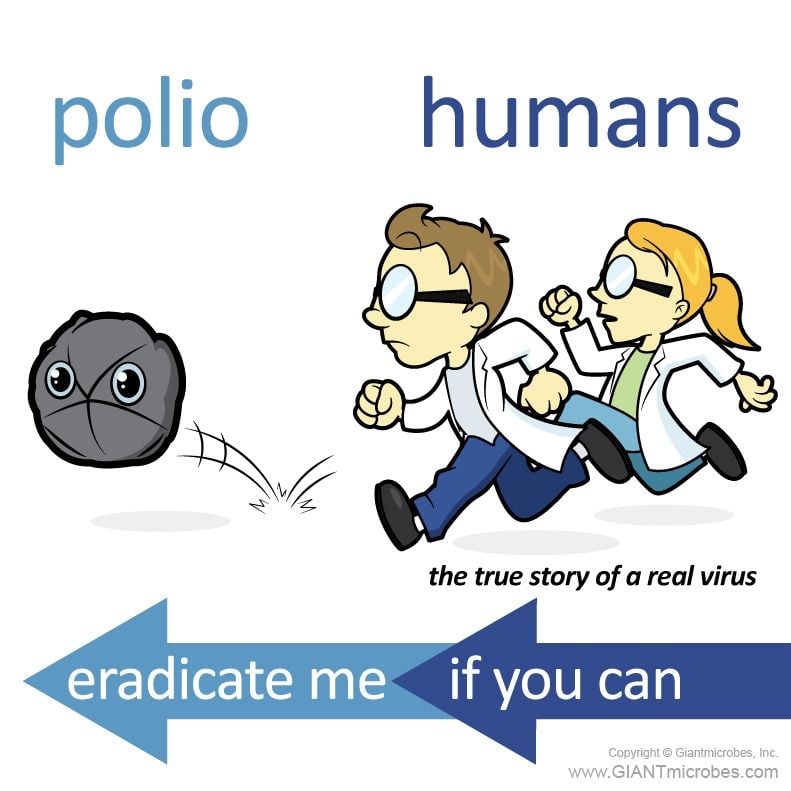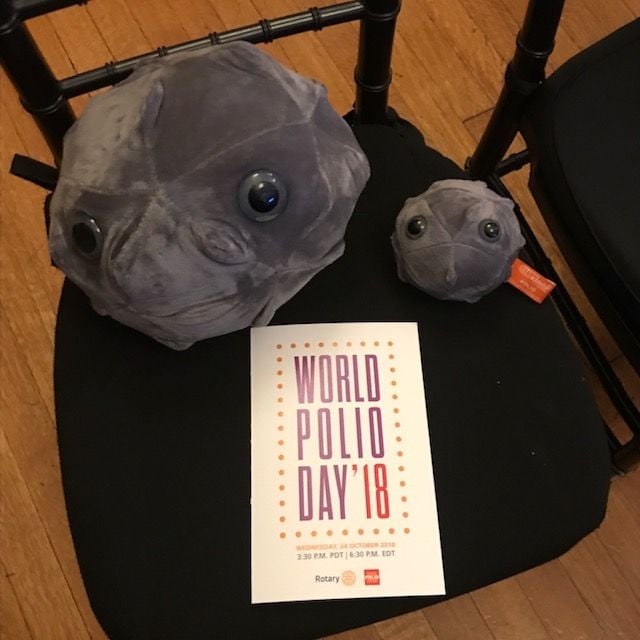Polio (Poliovirus)
Out of Stock

Your purchase supports Rotary International’s priority to End Polio Now by reaching every child with the polio vaccine. Thanks to the Bill & Melinda Gates Foundation, your contribution will be tripled. $1 from your purchase will be donated to Rotary. With the Gates matching gift, this $3 donation will protect a child for life against the poliovirus.
Product Details
Additional Information
| Sizes | Giantmicrobes are based on actual microbes, cells, organisms and other critters, only 1,000,000 times actual size! Gigantic (GG) 16-24" XL (XL) 10-15" Original (PD) 5-8" Keychain (KC) 2-4" with clip |
|---|---|
| Materials | Plush from all new materials. Stuffed with polyester fiber fill. Surface washable: sponge with water & soap, air dry. |
| Packaging | Each plush microbe includes a printed card with fun, educational and fascinating facts about the actual microbe or cell. |
| Safety | Every product meets or exceeds U.S. and European standards for safety. For ages 3 and up. |
All about Polio (Poliovirus)
FACTS: Although paralytic diseases have existed for ages, polio was the scourge of the early part of the 20th century. Ironically, up to 99% of the time, polio is asymptomatic, abortive, or non-paralytic, producing no symptoms, flu-like symptoms, or light-sensitivity and neck-stiffness. However, the petrifying consequences of paralytic polio (often spread during the summer months) were withered legs, paralyzed chest muscles, and in the worst cases, immersion into an “iron lung” breathing-machine. Though the illness passed after a few weeks, the paralytic effects could persist.
One theory suggests that modern sanitation may have actually helped trigger the epidemic of paralytic polio. Improved sewage systems greatly reduced incidents of the infant polio that confers immunity but tends to be non-paralytic. As polio was contracted in historically large numbers later in life, incidents of paralytic polio greatly increased.
Early vaccines developed during the 1930’s proved ineffective: indeed, a number of participants in the vaccine trails ended up developing polio. But in the late 1940’s, former flu-vaccine researcher Jonas Salk took up the task of developing a polio vaccine. By the early 1950’s, large-scale vaccine trials involving nearly 2 million children were being performed. On April 12, 1955 the success of the vaccine trials was announced to wide-spread acclaim. By 1957, polio cases in the United States had dropped by 90%.
Though most of the world is polio-free (with only a handful of cases recorded annually), wild poliovirus is still being reported in Pakistan and Afghanistan. Nevertheless, continued efforts to promote vaccination promise one day to paralyze polio. Permanently.
| Name | Its name comes from the Greek root “polios”, meaning gray. Before the virus was discovered, scientists believed this disease was caused by inflammation of gray matter in the spinal cord. |
|---|
| Actual Size | 30 nanometers – a million times smaller than a paperclip! |
|---|
| Where It Lives | Polio is a crippling disease caused by a virus that spreads by accidental ingestion of contaminated feces, or fecal-oral transmission. This virus multiplies in the intestines and sheds to the environment through feces. Rural communities without proper hygiene and sanitation are particularly at high risk. |
|---|
| Symptoms | About 90% of people who become infected have little to no symptoms. The less fortunate 10 percent, however, experience fever, tiredness, headaches, vomiting, stiffness in the neck, and pain in the arms and legs. One out of 200 infections will result in Acute Flaccid Paralysis, or AFP. This happens because the virus was able to penetrate the nervous system and destroy nerve cells. People with polio can have paralysis of their legs and lungs. |
|---|
| Cure | There aren’t any cures for it, but there is a highly effective vaccine available to prevent infection. The vaccine is a part of a larger public health movement called the Global Polio Eradication Initiative that has resulted in a 99.9% reduction in polio cases since 1988. |
|---|
| History |
The virus was discovered in 1908 by Austrian physicians, Karl Landsteiner and Erwin Popper. In 1955, Jonas Salk discovered the first vaccine against it. Salk also offered this wisdom: “Hope lies in dreams, in imagination and in the courage of those who dare to make dreams into reality. Big Outbreaks: 1894: The first polio epidemic in the U.S., infection 132 people. |
|---|
| Fascinating Facts |
In 1929, Philip Drinker invented a large tank designed to help polio patients breathe, called the iron lung. Don’t be misled by the name, it wasn’t the source of Iron Man’s powers! Famous people who had it: President Franklin Delano Roosevelt contracted polio in 1921 and went on to become President of the U.S. in 1933. |
|---|










